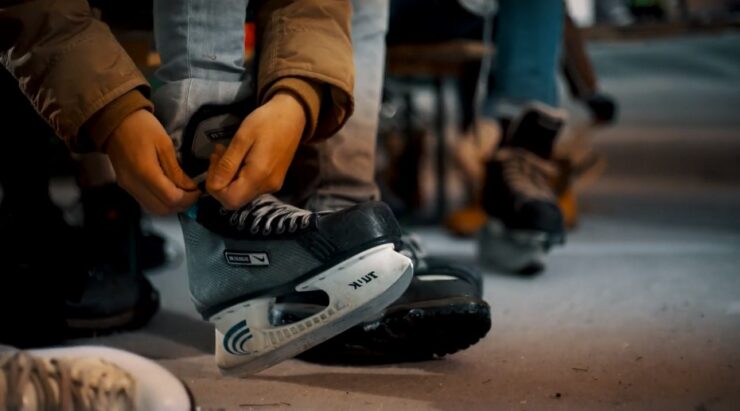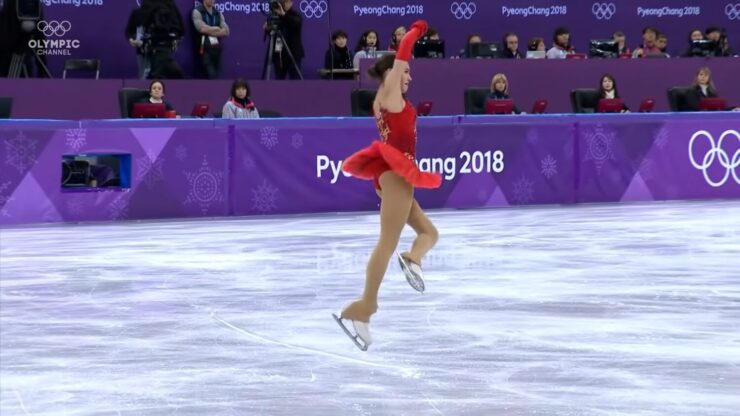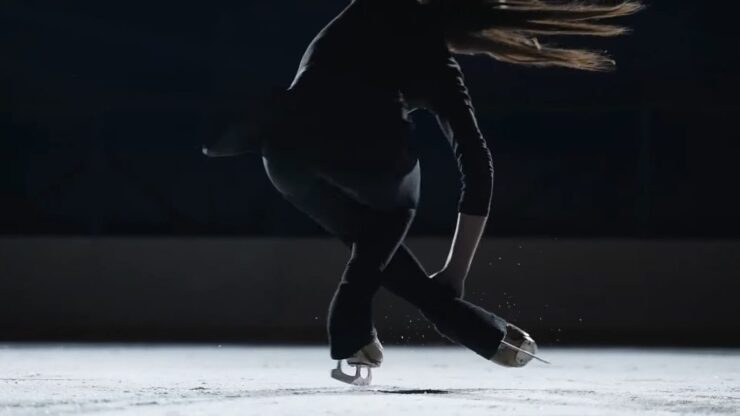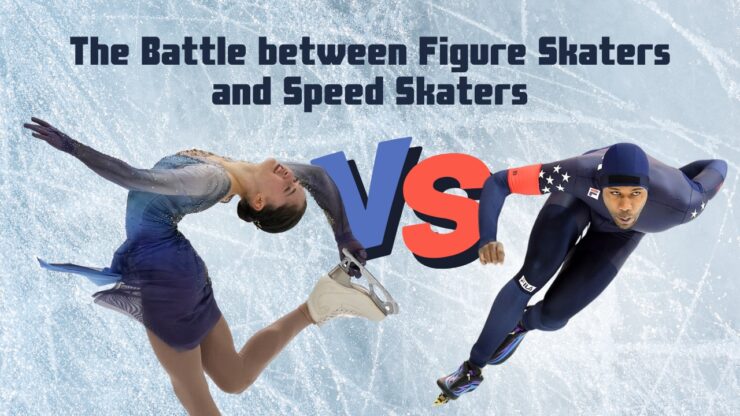Welcome to a thrilling journey across the frosty plains of ice skating disciplines. Today, we’re going to explore the profound contrasts and riveting similarities between figure skating and speed skating. Whether you’re a novice or a seasoned professional, there’s always something new to discover about these captivating sports.
As we slide through the history, the techniques, the equipment, and the high-stakes world of competition, we will gain a newfound appreciation for the precision of the figure skater’s twirl and the speed skater’s relentless pace. So, let’s lace up our skates and embark on this enlightening journey!
The Origins of Ice Skating Disciplines

Ice skating, as we know it today, has its roots steeped in survival rather than sport. Anthropological evidence suggests that primitive humans used rudimentary skates made from animal bones to traverse icy landscapes in search of food. However, the birth of figure skating and speed skating as organized sports came much later.
Figure skating was the first to emerge, evolving from a pastime in the frozen canals of the 18th-century Netherlands. It soon found its way into the royal courts of England, where it flourished into a demonstration of grace, precision, and artistry. The International Skating Union (ISU) was established in 1892, formalizing the rules and competitions for the sport. The first World Championships were held in 1896, and it has been a part of the Winter Olympics since its inception in 1924.
Speed skating, conversely, originated in Scandinavia and the Netherlands, where skaters would race on frozen rivers and canals. The first known speed skating events took place in the 19th century, and it was also included in the inaugural Winter Olympics in 1924. Unlike figure skating, speed skating is primarily about physical prowess and endurance, demanding athletes to cover distances as quickly as possible.
Technical Differences: Techniques and Movements
In figure skating, the main elements include jumps, spins, footwork, and choreographed sequences. Skaters must master the four basic jumps Salchow, toe loop, loop, and flip, along with their more complex counterparts like the Lutz and Axel. Spins can range from simple upright spins to complex combination spins. Furthermore, intricate footwork and ice dancing sequences require exceptional skill, precision, and musical interpretation.
Speed skating, on the other hand, is centered around maintaining maximum speed and efficient movements. The basic techniques involve long, gliding strides where skaters push off the inner edge of one skate and onto the outer edge of the other. It’s also crucial to maintain a low, aerodynamic posture. Moreover, turning techniques, such as crossovers in cornering, are essential to maintain speed and momentum.
The Importance of Artistry in Figure Skating
One aspect that distinctly sets figure skating apart is the emphasis on artistry. The performances are not just athletic displays but also a form of artistic expression. Each routine is choreographed to music, and skaters are judged not only on their technical elements but also on their presentation. This includes musical interpretation, timing, elegance, and the overall effect of the performance.
Figure skating combines elements of ballet and dance, demanding not just physical strength and technical prowess but also a strong emotional connection to the music and the narrative of the performance. This blend of art and athleticism is a unique characteristic of figure skating, giving it an undeniable appeal to audiences worldwide.
Speed Skating: The Pursuit of Velocity and Endurance
While figure skating celebrates the union of art and athleticism, speed skating leans toward the raw demonstration of power and endurance. There is no music, no costumes, and no choreography; the aim is simple be the fastest to cross the finish line.
In speed skating, there’s a breathtaking sense of velocity as athletes zoom around the ice at high speed. This sport requires not just speed but also endurance, especially in long-distance races that test the limits of the athletes’ strength and stamina. The beauty of speed skating lies in the seamless motion, the strategic game of drafting behind competitors, and the sheer willpower to outpace rivals.
Equipment Variances: Blades, Boots, and Suits

The equipment in both sports has evolved over time to optimize performance. Figure skates are designed for maneuverability and control. They have a set of serrated teeth known as toe picks at the front for jumps and spins, and the blade is slightly curved to allow for different types of footwork. The boots are stiff and high-ankled to provide support during jumps and landings.
Speed skates, however, are designed for maximum speed and efficiency. The blades are flat and longer than those of figure skates, allowing for longer glides with each stride. The boots are lower and offer less ankle support but provide better flexibility for the skating motion. As for clothing, figure skaters wear elaborate costumes in line with their performance’s theme, while speed skaters wear skin-tight suits to minimize air resistance.
Competitions and Scoring Systems
Competitions in figure skating and speed skating offer different challenges. In figure skating, competitors perform a short program and a free skate program, both involving a series of required elements. The skaters are judged based on the quality of their execution and their artistry. The judging system has evolved over time and currently follows the International Judging System, which allows for more objective scoring.
Speed skating races vary in distance from the sprint events to the grueling long-distance races. The objective is simple—the fastest time wins. Competitors skate in pairs, and their final ranking is based on their time rather than their finishing position in any given pair. In short-track speed skating, however, it’s a head-to-head competition where the first skater to finish wins.
Training Approaches: Precision versus Power
Figure skating and speed skating require different training approaches. Figure skaters need to hone their precision, technique, and artistic expression, along with building physical strength and flexibility. They spend countless hours practicing jumps, spins, and footwork, in addition to choreographing their routines and learning to express themselves on the ice.
Speed skaters, meanwhile, focus on developing power, speed, and endurance. Their training involves a mix of on-ice drills to improve technique and off-ice conditioning to build muscle strength and aerobic capacity. They also work on improving their starts, turns, and strategies to draft behind other competitors.
Physical Demands: Agility versus Stamina

Both figure skating and speed skating place significant physical demands on athletes, but in different ways. Figure skaters need to be agile, flexible, and strong, particularly in their core and lower body. The jumps and spins require explosive power, while the footwork and spins demand finesse and control.
In contrast, speed skating primarily requires strength, stamina, and cardiovascular fitness. Speed skaters need powerful leg muscles for fast, sustained striding. Additionally, maintaining a crouched position places a significant demand on their lower bodies, particularly on their quadriceps.
Choreography and Music in Figure Skating
The marriage of choreography and music gives figure skating its unique charm. Skaters perform to a wide range of music, from classical pieces to modern pop, and the choreography is designed to match the rhythm, tone, and emotion of the music. Choreographers and skaters work together to create programs that not only meet the technical requirements but also tell a story and connect with the audience. It’s this fusion of athleticism and artistry that makes figure skating such a captivating spectacle.
Olympic Glory: Figure Skating versus Speed Skating
Both figure skating and speed skating have been a part of the Winter Olympics since 1924, providing some of the most iconic moments in the history of the games. From the elegance of figure skating legends like Peggy Fleming and Yuzuru Hanyu to the unmatched speed of speed skating titans like Bonnie Blair and Sven Kramer, both disciplines showcase the extraordinary athleticism and tenacity of their competitors on the world’s biggest stage.
Choosing Your Path: Deciding between Figure Skating and Speed Skating

Choosing between figure skating and speed skating ultimately comes down to personal preference and natural inclination. Are you captivated by the expressive storytelling and balletic movements of figure skating, or does the pure, adrenaline-fueled speed and endurance of speed skating appeal more to you? Each path offers its unique challenges and rewards. But no matter which one you choose, both will offer you the joy of gliding across the ice, the thrill of competition, and the satisfaction of personal growth.
Final Words
Figure skating and speed skating, though fundamentally different, share a common essence—the exhilarating feeling of dancing on ice. Whether you’re drawn to the graceful pirouettes and expressive choreography of figure skating or the blistering speed and endurance test of speed skating, both disciplines offer a blend of athleticism, strategy, and sheer joy that’s hard to match in any other sport.
The choice between figure skating and speed skating isn’t about which is better, but rather, which speaks to your heart and your spirit. Because, in the end, that’s what truly matters.

